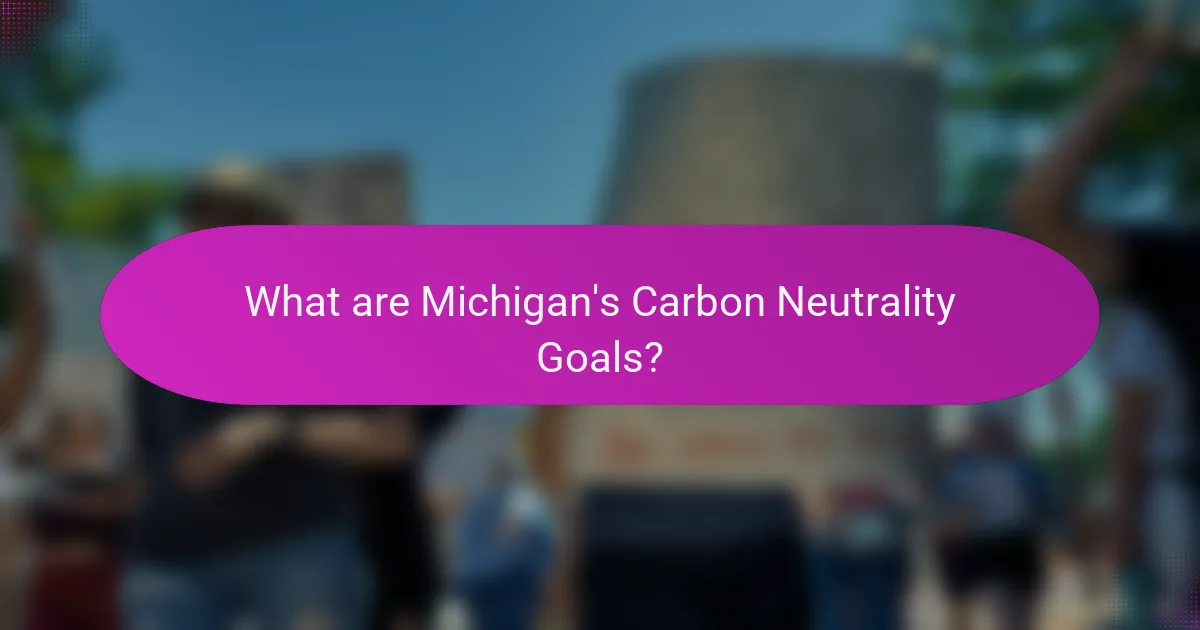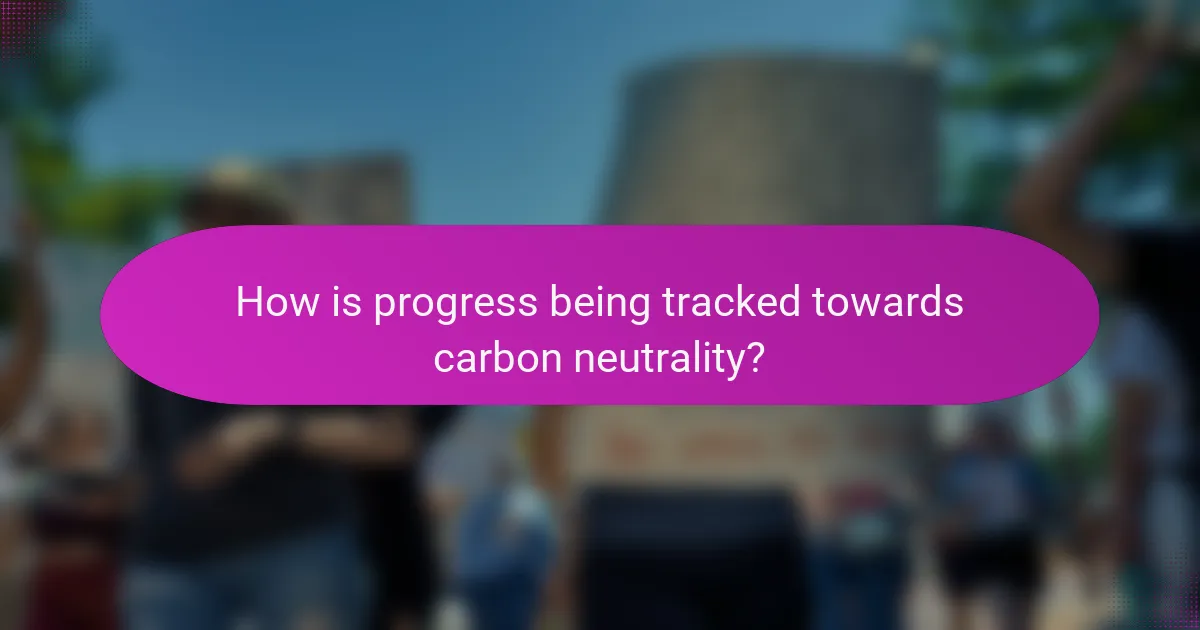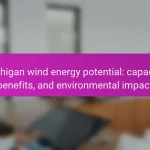
What are Michigan’s Carbon Neutrality Goals?
Michigan aims for carbon neutrality by 2050. This goal was established under the MI Healthy Climate Plan. The state targets a 28% reduction in greenhouse gas emissions by 2025. By 2030, the goal increases to a 52% reduction. The plan focuses on clean energy, energy efficiency, and sustainable transportation. Michigan also emphasizes community engagement and equity in its strategies. These goals align with national climate initiatives. Progress will be tracked through regular assessments and reports.
Why are carbon neutrality goals important for Michigan?
Carbon neutrality goals are important for Michigan to combat climate change. Achieving these goals can reduce greenhouse gas emissions significantly. Michigan’s economy relies heavily on industries that contribute to emissions. Transitioning to clean energy sources can create jobs in renewable sectors. The state aims to protect its natural resources and improve public health. Climate-related events have already impacted Michigan’s agriculture and infrastructure. Carbon neutrality can enhance resilience against these challenges. The goals align with national and global efforts to mitigate climate change.
What environmental impacts do these goals aim to address?
The Michigan Carbon Neutrality Goals aim to address several critical environmental impacts. These include reducing greenhouse gas emissions, improving air quality, and mitigating climate change effects. The goals focus on transitioning to renewable energy sources, which decreases reliance on fossil fuels. This transition is expected to lower carbon footprints significantly. Additionally, the goals aim to enhance biodiversity through habitat preservation and restoration. By promoting sustainable practices, they seek to reduce pollution in water bodies. Overall, these goals are designed to create a healthier ecosystem and promote environmental sustainability.
How do these goals align with national and global standards?
Michigan’s carbon neutrality goals align with national and global standards by targeting a 50% reduction in greenhouse gas emissions by 2030. This target is consistent with the U.S. commitment under the Paris Agreement to limit global warming to 1.5 degrees Celsius. Additionally, Michigan’s goals support the Biden Administration’s aim for a net-zero economy by 2050. The state’s strategies also reflect the Global Climate Action Framework, which encourages subnational entities to adopt ambitious climate policies. By integrating these standards, Michigan demonstrates its commitment to both local and international climate objectives.
What is the timeline for achieving carbon neutrality in Michigan?
Michigan aims to achieve carbon neutrality by 2050. This goal aligns with the state’s commitment to reducing greenhouse gas emissions. The timeline includes interim targets for 2025 and 2030. By 2025, Michigan plans to reduce emissions by 28% from 2005 levels. By 2030, the target is a 52% reduction. These milestones are part of the broader strategy outlined in the Michigan Climate Action Plan. The plan emphasizes renewable energy adoption and energy efficiency improvements. The state is also focusing on community engagement and equity in its transition to carbon neutrality.
What are the key milestones in Michigan’s carbon neutrality timeline?
Michigan aims for carbon neutrality by 2050. In 2019, the state established the Michigan Climate Action Plan. This plan set a target to reduce greenhouse gas emissions by 28% by 2025. In 2020, Governor Whitmer announced the MI Healthy Climate Plan. This plan outlined strategies for achieving carbon neutrality. By 2021, Michigan joined the U.S. Climate Alliance, committing to climate action. In 2022, the state released an updated greenhouse gas inventory. This inventory provided a baseline for tracking progress. These milestones reflect Michigan’s commitment to addressing climate change.
How have previous deadlines influenced current strategies?
Previous deadlines have significantly shaped current strategies for Michigan’s carbon neutrality goals. Historical deadlines created a framework for prioritizing actions and allocating resources. For instance, the 2025 target prompted early investments in renewable energy. This urgency led to the establishment of partnerships with local governments and businesses. The 2030 deadline has intensified efforts to enhance energy efficiency across sectors. Lessons learned from past deadlines have also improved stakeholder engagement processes. Data from previous initiatives informed adjustments to current strategies, ensuring they are more effective. Continuous evaluation of deadlines fosters accountability and drives progress toward achieving carbon neutrality.

What strategies are being implemented to achieve these goals?
Michigan is implementing various strategies to achieve its carbon neutrality goals. These strategies include transitioning to renewable energy sources. The state aims to increase the use of wind and solar energy significantly. Energy efficiency programs are also being expanded to reduce overall consumption. Additionally, Michigan is investing in electric vehicle infrastructure to promote cleaner transportation. The state government is collaborating with local communities to enhance sustainability initiatives. Policy frameworks are being developed to support green technology adoption. Public engagement campaigns are designed to raise awareness and encourage participation in carbon reduction efforts. These strategies are aligned with Michigan’s commitment to reducing greenhouse gas emissions by 28% by 2025.
What are the main strategies for reducing carbon emissions in Michigan?
The main strategies for reducing carbon emissions in Michigan include increasing renewable energy usage, enhancing energy efficiency, and promoting electric vehicle adoption. Michigan aims to generate 50% of its electricity from renewable sources by 2030. This transition significantly reduces reliance on fossil fuels. Energy efficiency programs target buildings and industrial processes to lower energy consumption. These initiatives can lead to a 20% reduction in emissions. Additionally, expanding electric vehicle infrastructure supports a shift away from gasoline-powered vehicles. The state has set a goal for 1 million electric vehicles on the road by 2030, which will further decrease carbon emissions.
How does the state plan to transition to renewable energy sources?
Michigan plans to transition to renewable energy sources by implementing a comprehensive energy strategy. This strategy includes increasing the use of wind and solar power. The state aims for 50% of its electricity to come from renewable sources by 2030. Additionally, Michigan is investing in energy efficiency programs to reduce overall consumption. The plan also involves modernizing the electric grid to support renewable integration. Michigan’s legislation mandates a gradual phase-out of coal-fired power plants. Financial incentives will encourage businesses and homeowners to adopt renewable technologies. These measures align with Michigan’s carbon neutrality goals set for 2050.
What role do transportation and infrastructure play in these strategies?
Transportation and infrastructure are critical to Michigan’s carbon neutrality strategies. They facilitate the reduction of greenhouse gas emissions through improved public transit and electric vehicle adoption. Enhanced infrastructure supports renewable energy integration, such as charging stations for electric vehicles. Investments in sustainable transportation options can lead to decreased reliance on fossil fuels. For example, the Michigan Department of Transportation aims to increase public transit ridership by 20% by 2030. Efficient infrastructure also promotes active transportation, like biking and walking, which further lowers emissions. Overall, strategic planning in transportation and infrastructure is essential for achieving Michigan’s carbon neutrality goals.
What policies support Michigan’s carbon neutrality efforts?
Michigan’s carbon neutrality efforts are supported by several key policies. The state’s Climate Action Plan aims for a 28% reduction in greenhouse gas emissions by 2025. The Clean and Renewable Energy Plan promotes the use of clean energy sources. Michigan’s Public Act 342 mandates utilities to increase their renewable energy portfolio. The state has also set a goal of achieving 100% carbon-free electricity by 2035. Additionally, the MI Healthy Climate Plan outlines strategies for reducing emissions across various sectors. These policies collectively aim to transition Michigan towards a sustainable, low-carbon economy.
How do state regulations impact carbon reduction initiatives?
State regulations significantly influence carbon reduction initiatives by establishing legally binding targets and frameworks. These regulations can mandate emissions reductions, promote renewable energy adoption, and incentivize energy efficiency. For example, Michigan’s Clean Energy Act sets specific goals for renewable energy usage. This act pushes utilities to transition towards cleaner energy sources. Furthermore, regulations can provide funding opportunities for green projects. They can also facilitate collaboration between state agencies and private sectors. According to the U.S. Environmental Protection Agency, states with strong regulatory frameworks see more substantial progress in reducing greenhouse gas emissions. Thus, effective state regulations are crucial for achieving meaningful carbon reduction outcomes.
What incentives are available for businesses and residents to participate?
In Michigan, various incentives are available for businesses and residents to participate in carbon neutrality initiatives. These include tax credits for renewable energy installations, grants for energy efficiency upgrades, and rebates for electric vehicle purchases. The state also offers low-interest loans for energy-related projects. Additionally, there are programs that provide technical assistance and resources for sustainable practices. According to the Michigan Department of Environment, Great Lakes, and Energy, these incentives aim to reduce greenhouse gas emissions and promote clean energy. Participation can lead to cost savings and environmental benefits for both businesses and residents.

How is progress being tracked towards carbon neutrality?
Progress towards carbon neutrality is tracked through various metrics and reporting frameworks. These include greenhouse gas (GHG) emissions inventories, which quantify emissions from different sectors. Regular assessments are conducted to evaluate the effectiveness of implemented strategies. Data collection occurs at local, state, and federal levels to ensure comprehensive monitoring. The Michigan Department of Environment, Great Lakes, and Energy (EGLE) plays a key role in this tracking. They publish annual reports detailing progress and updates on carbon reduction initiatives. Additionally, stakeholder engagement is encouraged to align efforts and share best practices. This systematic approach allows for transparent evaluation of Michigan’s carbon neutrality goals.
What metrics are used to measure Michigan’s progress?
Michigan’s progress towards carbon neutrality is measured using several key metrics. These include greenhouse gas emissions reductions, energy efficiency improvements, and renewable energy adoption rates. The state tracks emissions through comprehensive inventories conducted every few years. Energy efficiency is assessed via programs that measure reductions in energy consumption across sectors. Renewable energy metrics focus on the percentage of energy generated from renewable sources. Additionally, Michigan evaluates progress through economic indicators related to clean energy job growth. These metrics provide a clear framework for monitoring advancements towards carbon neutrality goals.
How often is progress reported to the public?
Progress on Michigan’s carbon neutrality goals is reported to the public annually. This reporting includes updates on strategies and milestones achieved. The Michigan Department of Environment, Great Lakes, and Energy oversees this process. Reports are typically released in the first quarter of each year. This annual reporting ensures transparency and accountability to stakeholders. Additionally, interim updates may be provided through public meetings or press releases. These updates keep the community informed about ongoing efforts and progress.
What challenges are faced in tracking carbon emissions accurately?
Accurately tracking carbon emissions faces several challenges. One significant challenge is the lack of standardized measurement methodologies. Different organizations may use varying methods, leading to inconsistent data. Another issue is the complexity of emissions sources. Emissions can arise from numerous sectors, including transportation, industry, and agriculture. Each sector has unique characteristics that complicate tracking efforts. Additionally, data collection can be hindered by insufficient resources. Many organizations lack the funding or technology needed for comprehensive tracking. Furthermore, the dynamic nature of emissions adds another layer of difficulty. Changes in policies, technologies, and behaviors can rapidly alter emission levels. According to the World Resources Institute, these factors can lead to significant discrepancies in reported emissions. Addressing these challenges is essential for effective carbon management and achieving climate goals.
How can residents contribute to Michigan’s carbon neutrality goals?
Residents can contribute to Michigan’s carbon neutrality goals by adopting sustainable practices. They can reduce energy consumption through energy-efficient appliances and smart home technologies. Utilizing public transportation or carpooling can decrease greenhouse gas emissions. Residents can also support local renewable energy initiatives, such as community solar projects. Participating in tree-planting programs helps enhance carbon sequestration. Engaging in recycling and composting reduces waste and lowers landfill emissions. Educating themselves and others about climate issues fosters community awareness and action. According to the Michigan Department of Environment, Great Lakes, and Energy, collective actions at the community level significantly impact state-wide carbon reduction efforts.
What actions can individuals take to support these efforts?
Individuals can support Michigan’s carbon neutrality goals by reducing their carbon footprint. They can use public transportation or carpool to lower vehicle emissions. Implementing energy-efficient practices at home, such as using LED lighting, can significantly reduce energy consumption. Additionally, individuals can support renewable energy sources by choosing green energy options from their utility providers. Participating in local tree planting initiatives helps absorb carbon dioxide from the atmosphere. Advocating for sustainable policies and practices within their communities can create a broader impact. Engaging in educational programs about climate change raises awareness and encourages collective action. Supporting local businesses that prioritize sustainability contributes to a greener economy.
How can communities collaborate to enhance local initiatives?
Communities can collaborate to enhance local initiatives by forming partnerships and sharing resources. Collaborative efforts can include joint projects that address specific local needs. For instance, communities can work together on sustainability initiatives, such as community gardens or renewable energy projects. Sharing knowledge and best practices among local organizations can also improve project outcomes. Regular meetings and workshops can facilitate communication and foster a sense of community. Engaging local stakeholders, including residents and businesses, ensures that initiatives reflect community needs. Successful collaborations often lead to increased funding opportunities and support from local governments. Evidence shows that communities that collaborate effectively can achieve greater impact and sustainability in local initiatives.
Michigan’s Carbon Neutrality Goals aim for carbon neutrality by 2050, with interim targets of a 28% reduction in greenhouse gas emissions by 2025 and a 52% reduction by 2030, as outlined in the MI Healthy Climate Plan. The article details the importance of these goals for environmental sustainability, economic growth, and public health, while also addressing key strategies for achieving them, including transitioning to renewable energy, enhancing energy efficiency, and promoting sustainable transportation. It further explores the policies supporting these initiatives, the metrics for tracking progress, and the role of community engagement in driving local efforts toward carbon neutrality.

